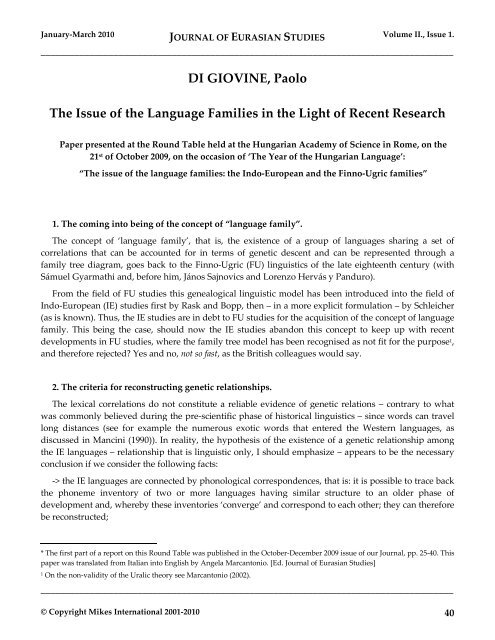EurasianStudies_0110..
EurasianStudies_0110..
EurasianStudies_0110..
Create successful ePaper yourself
Turn your PDF publications into a flip-book with our unique Google optimized e-Paper software.
January-March 2010 JOURNAL OF EURASIAN STUDIES Volume II., Issue 1.<br />
_____________________________________________________________________________________<br />
DI GIOVINE, Paolo<br />
The Issue of the Language Families in the Light of Recent Research<br />
Paper presented at the Round Table held at the Hungarian Academy of Science in Rome, on the<br />
21 st of October 2009, on the occasion of ‘The Year of the Hungarian Language’:<br />
“The issue of the language families: the Indo-European and the Finno-Ugric families”<br />
1. The coming into being of the concept of “language family”.<br />
The concept of ‘language family’, that is, the existence of a group of languages sharing a set of<br />
correlations that can be accounted for in terms of genetic descent and can be represented through a<br />
family tree diagram, goes back to the Finno-Ugric (FU) linguistics of the late eighteenth century (with<br />
Sámuel Gyarmathi and, before him, János Sajnovics and Lorenzo Hervás y Panduro).<br />
From the field of FU studies this genealogical linguistic model has been introduced into the field of<br />
Indo-European (IE) studies first by Rask and Bopp, then – in a more explicit formulation – by Schleicher<br />
(as is known). Thus, the IE studies are in debt to FU studies for the acquisition of the concept of language<br />
family. This being the case, should now the IE studies abandon this concept to keep up with recent<br />
developments in FU studies, where the family tree model has been recognised as not fit for the purpose 1,<br />
and therefore rejected? Yes and no, not so fast, as the British colleagues would say.<br />
2. The criteria for reconstructing genetic relationships.<br />
The lexical correlations do not constitute a reliable evidence of genetic relations – contrary to what<br />
was commonly believed during the pre-scientific phase of historical linguistics – since words can travel<br />
long distances (see for example the numerous exotic words that entered the Western languages, as<br />
discussed in Mancini (1990)). In reality, the hypothesis of the existence of a genetic relationship among<br />
the IE languages – relationship that is linguistic only, I should emphasize – appears to be the necessary<br />
conclusion if we consider the following facts:<br />
-> the IE languages are connected by phonological correspondences, that is: it is possible to trace back<br />
the phoneme inventory of two or more languages having similar structure to an older phase of<br />
development and, whereby these inventories ‘converge’ and correspond to each other; they can therefore<br />
be reconstructed;<br />
* The first part of a report on this Round Table was published in the October-December 2009 issue of our Journal, pp. 25-40. This<br />
paper was translated from Italian into English by Angela Marcantonio. [Ed. Journal of Eurasian Studies]<br />
1 On the non-validity of the Uralic theory see Marcantonio (2002).<br />
_____________________________________________________________________________________<br />
© Copyright Mikes International 2001-2010 40

















